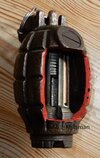I bought this in the form of a moneybox, where a slot had been cut under the filler screw.
It seemed a good opportunity to make a sectioned grenade. When I enlarged the slot into a large opening it was clear there were air bubbles in the casting. All the Mills specifications to manufacturers states bodies 'must be free from blowholes and flaws', so perhaps this was part of a batch of grenades that failed inspection. A % of bodies in each batch would be sawn up to check for the uniform thickness of the casting and to look for flaws and blowholes.
You can see the holes on the right hand side of the opening.

It seemed a good opportunity to make a sectioned grenade. When I enlarged the slot into a large opening it was clear there were air bubbles in the casting. All the Mills specifications to manufacturers states bodies 'must be free from blowholes and flaws', so perhaps this was part of a batch of grenades that failed inspection. A % of bodies in each batch would be sawn up to check for the uniform thickness of the casting and to look for flaws and blowholes.
You can see the holes on the right hand side of the opening.

